His Majesty King Bhumibol Adulyadej The Great
Chapter 1: The Royal House of Chakri
A chronicle recorded 221 years ago that…
“On Saturday, the waning 9th day of the 5th month in the Year of the Tiger, Chula Sakarat 1144, at a little past 2 o’clock in the afternoon, during an auspicious time, a royal decree was issued to establish Bangkok as the capital on the eastern bank. The sun remained eclipsed for seven days. On Sunday, the waxing 10th day of the 6th month in the Year of the Tiger, Chula Sakarat 1144, at 6:54 a.m., the auspicious moment was chosen to lay the city pillar.”
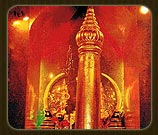
City Pillar
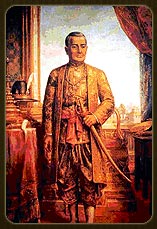
His Majesty King Buddha Yodfa Chulaloke the Great
The Chakri Dynasty, whose first monarch was His Majesty King Buddha Yodfa Chulaloke the Great, was named ‘Chakri’ by royal decree. This was inspired by the fact that His Majesty’s progenitor, the First King’s father, held the position of Chao Phraya Chakri of Phitsanulok, and His Majesty himself had once been appointed as Chao Phraya Chakri during the Thonburi period. As an auspicious symbol, His Majesty graciously commanded the creation of the Chakra (disc) and Trident as emblems of the Chakri Dynasty.
The Chakra and Trident were crafted from alloyed metal. The disc had a diameter of 17.5 centimeters, adorned with gold patterns on its surface, and the edges of the disc were encased in gold, which could be removed if needed. The Trident consisted of a shaft and three prongs, each double-edged like a ceremonial sword. The shaft was covered with engraved gold patterns and had a ruby embedded at the tip. At the base of the central prong, a figure of Vishnu riding Garuda was cast and decorated with gold. The central prong measured 15 centimeters in length. Upon completion, the Chakra and Trident were brought into the ceremonial hall to be used in the coronation ceremony, marking His Majesty’s ascension to the throne.
The Chakra and Trident, which His Majesty King Buddha Yodfa Chulaloke the Great graciously commanded to be created at that time, are considered part of the royal regalia known as the Ashtadasha Weapons, or the Eight Royal Weapons of the King. These comprise: the Diamond-tipped Spear, the Captive Sword, the Trident, the Chakra (Disc), the Khan Sword, the Bow, the Conquering Lance, and the River-crossing Gun.
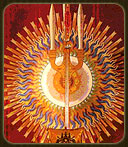
The Chakra and Trident
Origin of the Name ‘Chakri’
The Chakra (Disc) and Trident, besides being symbols of the Chakri Dynasty, also carry meanings connected to various aspects of Thai beliefs. The Chakra, known as a sharp weapon, is described in the Ramakien as the divine weapon of a principal deity in the Brahmanic tradition, namely Lord Vishnu. This divine Chakra has a specific name: ‘Chakrasutras’ or ‘Vajranara’.Whenever a major upheaval occurs in the world and Lord Vishnu is to incarnate to relieve suffering, this Chakra descends as his weapon or instrument. For example, when Lord Vishnu incarnated as Rama in the Ramakien, this sacred Chakra manifested as a weapon known as Phra Phrot, which aided him in defeating the demons of that time.

Lord Vishnu
The belief that the Chakra manifests as a sacred emblem of merit has been passed down through the ages. In later periods, it became a common belief that a monarch who possesses great merit and can rule all directions, known as a Chakravartin (universal monarch), will have a Chakra appear as a symbol of their divine authority.
According to Brahmanic tradition, only those with extraordinary virtue and power can possess a Chakra as their emblem of merit. A king in such a position is regarded as a deity in human form. Therefore, a sovereign with supreme authority can govern countries across all regions, with the four oceans marking the boundaries of his realm. Such a king, who conducts himself righteously, is respected, revered, and worshipped, and is known as a Dharmaraja or righteous king.
It is also believed that a Chakravartin will possess special treasures, which manifest through his merit and spiritual power. These treasures include the seven precious items: the Crystal Chakra, the Crystal Elephant, the Crystal Horse, the Crystal Gem, the Celestial Maiden, the Crystal Treasury, the Crystal General, or even a thousand precious jewels (representing noble offspring).
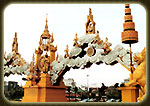
Crystal Chakra
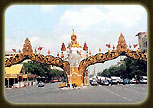

Crystal Elephant
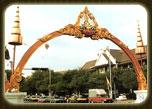
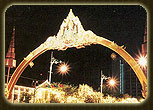
Crystal Horse
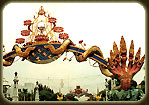
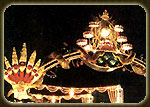
The Crystal Gem

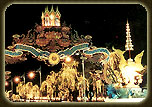
Celestial Maiden
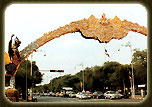
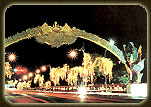
Crystal Treasury
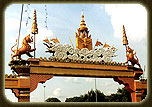
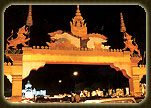
Crystal General (Parinayaka Ratna), or a thousand crystal offspring (noble children)

The Seven Precious Treasures, photographed from newly recreated statues for the purpose of spiritual theater, at Suan Mokkhapalaram, Chaiya District, Surat Thani Province.
The Seven Royal Treasures (Satta Rattana). From left to right, the Seven Royal Treasures are: the Wondrous Lady (Naga-lady), the Divine Wheel (Chakra-jewel), the Ideal Minister (Minister-jewel), the Wealthy Householder (Treasurer-jewel), the Precious Elephant (Elephant-jewel), the Precious Horse (Horse-jewel), and the Wish-Fulfilling Jewel (Mani-jewel) — the round gem placed in front of the person with palms pressed together in a gesture of reverence. The Chakravartin, or Universal Monarch, is seated beneath the royal parasol held by an attendant standing behind him. The person with joined palms symbolizes one who is offering or presenting these treasures to the king.
Note:
The Seven Royal Treasures, as illustrated in the sculpture of the Chakravartin surrounded by his seven treasures (a modern reconstruction for the spiritual theatre at Suan Mokkh Forest Monastery, Chaiya District, Surat Thani Province), have the following symbolic meanings: Wondrous Lady (Naga-lady): Represents the ideal wife, and by extension, the excellence of all domestic and inner-court affairs. Divine Wheel (Chakra-jewel): Symbolizes the best military and political power. Ideal Minister (Minister-jewel): Represents the most capable and righteous public officials. Wealthy Householder (Treasurer-jewel): Stands for prosperous citizens and economic stability. Precious Elephant (Elephant-jewel): Denotes the finest means of heavy transport — in modern terms, this could refer to the railway system. Precious Horse (Horse-jewel): Signifies the best form of communication and transport — in today’s context, this could be interpreted as modern telecommunication systems, as horses were historically used to deliver messages. Wish-Fulfilling Jewel (Mani-jewel): Represents the supreme wisdom of the Chakravartin, as it stands for the source of boundless success and well-being.
These seven treasures illustrate how essential each element is for a just and prosperous ruler, and by extension, for the governance of a peaceful and orderly society.
According to the Sumangalavilasini Commentary, Volume II, the Chakra-ratana, or the Divine Wheel, and the qualities of a Universal Monarch are described as treasures that appear only among human beings, of immeasurable value, unlike other worldly gems, extremely rare, and arising only occasionally, and only for those who possess exceptional qualities such as physical beauty, noble lineage, righteous conduct, and royal authority; thus, the Universal Monarch is described as having an attractive appearance, a long life free from illness, beloved by people of all classes, and possessing the unique Seven Royal Treasures, with a noble way of life, conquering enemies through righteousness, ruling the land with justice, alleviating suffering and promoting the well-being of his people with the oceans as the borders of his realm, and being the one who causes the Divine Wheel to turn.
Particularly in Thai Brahmanical tradition, this concept is reflected in the naming of Thailand’s capitals which often include the word Ayodhya or Ayutthaya, and in the royal names of Thai monarchs throughout history that incorporate the name Rama, which has its roots in the character of Rama, king of Ayodhya, from the Ramakien; consequently, Thai kings have long adopted the Chakra, the divine weapon of Vishnu, both as a symbol inherited from Vishnu and as a representation of their Vishnu-like power, as seen in its use on state seals and ancient coinage such as pod duang.
Meanwhile, another divine weapon, the Trishula or trident, is the weapon of Shiva (Phra Isuan), not of Vishnu, and is specifically called Pināka; King Vajiravudh (Rama VI), who possessed profound knowledge of ancient Indian traditions and was honored as “The Great Scholar King,” explained in his writings on gods and sacred knowledge that the Trishula is not Vishnu’s weapon but belongs to Shiva, a distinction also found in his poetic work Lilit Narai Sip Pang, in the section where blessings are requested from the gods.
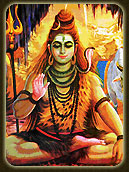
๏ วิษณุนาถกาจแกล้ว สรวงทรง ฤทธิ์แฮ แผ้วปลอดมฤตยู เดชห้าว อาสนะองค์งูเป็น ผทมสุข กลืนฟ้าด้าวเทพแกว่น แด่นดิน
๏ ปิ่นเอาครุฑขี่ดั้น เมฆี กรสี่กุมสังข์จักร เพริดแพร้ว
คฑาอีกธรณี ถือเหมาะ
บำราบอสูรแล้ว แหลกลาน
Permanent Structures and Symbols Associated with “Chakri”
Both the Chakra (divine discus) and the Trishula (trident), when combined into the term “Chakri,” form a name that is considered highly auspicious and meaningful. This significance is directly connected to the name “Chakri”, the dynastic title of Thailand’s current royal family — the Chakri Dynasty. On certain occasions, monarchs from this royal lineage have initiated the construction of permanent objects and ceremonial practices that bear the dynasty’s name.
For instance, during the reign of King Rama I, Phra Phutthayotfa Chulalok the Great, a royal command was issued to create the Chakri emblem, featuring a white chakra — representing the name of the royal house — set against a red field, to serve as the official flag of royal naval vessels. This Chakri flag remained in use throughout his reign and came to symbolize the sovereign authority and naval identity of the Chakri Dynasty.

The Red Flag with White Chakra

A red flag with a white chakra and a white elephant at the center.
During the reign of King Rama II, it was recorded that three exceptional white elephants were presented to the monarch. Therefore, he graciously ordered that the image of a white elephant be added to the Chakra emblem during this reign.
Later, King Mongkut (Rama IV) held the view that the Chakra emblem should be an exclusive symbol of the sovereign. Consequently, he commanded the removal of the white elephant image from the emblem.

To distinguish the royal naval flag from the national flag used by the people, it was decreed that royal ships fly a blue flag featuring a white elephant at the center. Later, in 1891 (B.E. 2434), the design was revised to a red field with a fully decorated white elephant standing on a pedestal in the center, and a chakra emblem placed in the upper corner of the flag.
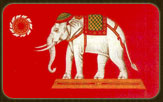
A red flag with a fully decorated white elephant standing on a pedestal in the center, and a chakra emblem in the upper corner.
During the reign of King Chulalongkorn (Rama V), also known as King Piyamaharaj, to commemorate the 100th anniversary of the founding of the Rattanakosin Kingdom by King Phutthayotfa Chulalok the Great (Rama I), King Chulalongkorn graciously ordered the construction of the Chakri Maha Prasat Throne Hall. Construction began at the end of 1875 (B.E. 2418) and was completed in 1882 (B.E. 2425). The architectural design is a blend of styles: the main structure follows the European architectural style of the time, while the roof features traditional Thai architecture with three tiered spires arranged from east to west.
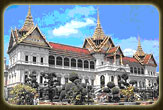
Chakri Maha Prasat Throne Hall
Additionally, during the grand celebration of the capital city in 1882 (B.E. 2425), His Majesty graciously ordered the creation of a royal decoration named The Most Illustrious Order of the Royal House of Chakri. This honor was established to be bestowed upon members of the royal family who are direct descendants of King Phutthayotfa Chulalok the Great (Rama I), as well as those who have married into the royal family or other distinguished individuals deemed worthy of receiving this royal honor.

Most Illustrious Order of the Royal House of Chakri
In addition to the construction of permanent structures and monuments, the term “Chakri” was also adopted in the naming of royal ceremonies associated with the Chakri Dynasty. During the reign of King Vajiravudh (Rama VI), His Majesty instituted an annual tradition of paying homage on April 6, the date marking the arrival of King Ramathibodi I (King Phutthayotfa Chulalok the Great) in the capital. His Majesty decreed that this day be officially known as “Chakri Day” and observed as such from that time onward.
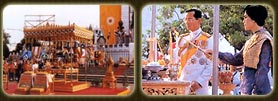
Chakri Memorial Day
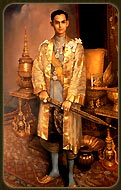
His Majesty King Bhumibol Adulyadej the Great
The Royal Dynasties of Thailand
The Chakri Dynasty is the eighth royal dynasty in the history of Thailand, following a succession of monarchs from various royal lineages. These include:
the Phra Ruang Dynasty during the Sukhothai period, the Chiang Rai Dynasty, the Suphannaphum Dynasty, the Sukhothai Dynasty (of the Ayutthaya period), the Prasat Thong Dynasty, the Ban Phlu Luang Dynasty, the Thonburi Dynasty, and finally the Chakri Dynasty of the Rattanakosin period, which continues to the present day.
After the establishment of Rattanakosin as the capital city in 1782 (B.E. 2325), monarchs of the Chakri Dynasty have continued to ascend the throne in unbroken succession. As of 2004 (B.E. 2547), this reign had lasted 222 years, comprising nine reigns. His Majesty King Bhumibol Adulyadej the Great (Rama IX), a monarch of deep benevolence and wisdom, was the ninth sovereign of the Royal House of Chakri, as illustrated in the following lineage chart.
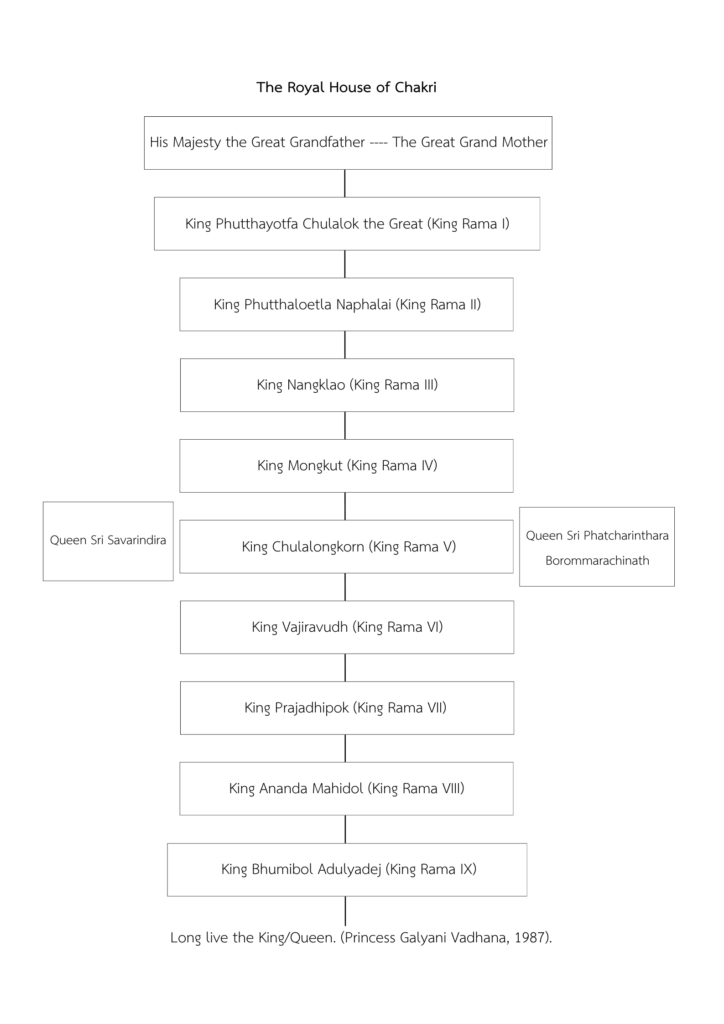

The Royal House of Chakri
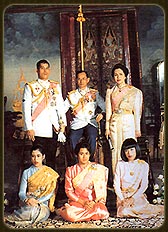
The Monarchy in Thailand
In Thailand, the monarchy serves as the spiritual center of the nation — a symbol of unity, love, and harmony that binds the people together as one. The relationship between the King and the people is often likened to that of a father and his children, a deep and enduring bond that has existed since the founding of the nation and continues to this day. As such, the monarchy is considered the most important institution in the country. It provides emotional stability to society, contributing greatly to national development and the resolution of challenges in all areas.
The loyalty of the Thai people toward the monarch is unique when compared to other societies. It is a profound, heartfelt, and unwavering devotion — one that holds the monarchy in the highest reverence, even to the point of self-sacrifice. In times of crisis, whether internal or external, the King has often played a vital role in resolving conflicts and restoring stability in ways that are truly remarkable. This special relationship between the Thai monarchy and its people is a distinctive characteristic of the nation — one that has endured for generations.

